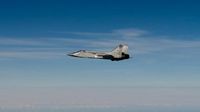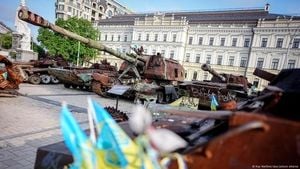On September 19, 2025, the skies above Estonia became the stage for a tense, almost surreal encounter between NATO and Russian forces. Three Russian MiG-31 fighter jets—capable of carrying nuclear-tipped Kinzhal hypersonic missiles—breached Estonian airspace near the Gulf of Finland, igniting a 12-minute standoff that has since drawn international attention and heightened anxieties across Europe. According to The Telegraph and The Sun, two Italian F-35 pilots, flying NATO’s most advanced jets, were scrambled from Amari airbase, just 50 kilometers from Tallinn, to intercept the Russian aircraft. What followed was a silent ballet: the Italians rocked their wings, a standard interception maneuver, and the Russian pilots mirrored the gesture, one even offering a surprising wave. No words were exchanged over the radio as both sides maintained radio silence, trailing each other until the Russian jets returned to the Kaliningrad enclave.
While this episode ended without shots fired, its implications have been anything but peaceful. Estonian Foreign Minister Margus Tsakhna didn’t mince words, calling the incident “unprecedentedly brazen” and noting it was the fourth such violation of Estonian airspace by Russian forces in 2025 alone. “Russia’s increasingly extensive testing of boundaries and growing aggressiveness must be met with a swift increase in political and economic pressure,” Tsakhna said, as quoted by The Sun. NATO officials echoed his alarm, describing the breach as “yet another example of reckless Russian behavior and NATO's ability to respond.”
The encounter over Estonia is just one in a string of recent provocations by Moscow, which many analysts believe are part of a broader campaign to test the unity and resolve of NATO. Natia Seskuria, an associate fellow at the Royal United Services Institute, told The Independent, “I think Putin is basically testing a Western response by trying to violate Polish airspace, which is a major NATO ally, and he’s trying to find out basically whether there is such thing as NATO unity when it comes to responding to these acts of aggression.”
Indeed, the Baltic region and its neighbors have seen a marked uptick in both aerial and hybrid incursions over the past month. On September 9, Polish authorities reported 19 separate drone incursions into their airspace, many of which originated from Belarus. The Polish military responded by scrambling fighter jets and placing Patriot missile defense systems on alert. Prime Minister Donald Tusk warned parliament that the country was “closer to military conflict than at any time since the Second World War.” Three drones were confirmed shot down, with a fourth likely destroyed, and the incident marked the first direct NATO engagement with Russian forces since the 2022 invasion of Ukraine, according to The Sun.
Romania, too, found itself in the crosshairs. On September 13, its air force scrambled F-16 fighter jets after a Russian drone entered Romanian airspace, flying so low that pilots nearly engaged it before it veered back toward Ukraine. Just a week later, on September 20, a Russian drone reportedly overflew Romanian territory for nearly an hour, once again prompting a military response. These repeated incursions have left defense officials in the region on edge, with many viewing them as deliberate provocations meant to probe NATO’s readiness and political will.
Denmark experienced its own security scare in mid-September, when overnight drone activity was detected near four major airports, including Copenhagen. The Danish defense minister described the incidents as the work of a “professional actor” and said Russian involvement could not be ruled out, though Moscow denied any role. The situation was serious enough that Denmark began considering whether to invoke NATO Article 4, which would trigger formal consultations among alliance members—a step already taken by Poland and Estonia following recent airspace violations.
These aerial provocations have been accompanied by a series of joint Russian-Belarusian military exercises, dubbed Zapad 2025, which kicked off earlier this month. Though originally slated to involve 13,000 troops along Belarus’s western border, the maneuvers were scaled back and moved deeper into the country. Still, the exercises have unsettled NATO members in the region, including Latvia, Lithuania, and Poland. As Ms. Seskuria pointed out, “These exercises in the past have been used for Russia to escalate the real conflict. In 2008, for example, against Georgia and then against Ukraine, Russia has used these drills as a preparation for the actual war.”
But Russia’s playbook extends beyond conventional military moves. Hybrid tactics—ranging from cyberattacks and sabotage to sophisticated disinformation campaigns—have become a hallmark of Moscow’s approach to destabilizing its adversaries. The UK’s National Cyber Security Centre determined that Russia was responsible for a major Europe-wide cyberattack in 2022, launched just an hour before its invasion of Ukraine. The attack targeted not only Ukraine’s military but also wind farms, internet users, and infrastructure across central Europe. Disinformation efforts have also ramped up, with pro-Russian narratives seeking to portray the West as the true aggressor. “There are consistent efforts to push these narratives that are pro-Russian, portraying the West as an aggressor rather than a Kremlin that wants to violate Ukraine’s sovereignty and fights this war for its own imperial ambitions,” Ms. Seskuria explained to The Independent.
The international response has been swift and, at times, sharply worded. Former U.S. President Donald Trump, speaking at the United Nations on September 23, declared that Ukraine “may be able to take back their country in its original form and, who knows, maybe even go further than that.” He also mocked Russia’s military prowess, calling it a “paper tiger” and dismissing its economic strength. Kremlin spokesperson Dmitry Peskov fired back, insisting, “Russia is more associated with a bear. And paper bears don’t exist. Russia is a real bear.” Peskov did, however, concede that the Russian economy had faced “tensions.”
European leaders, meanwhile, have called for increased vigilance and unity. EU foreign policy chief Kaja Kallas labeled the Estonian airspace violation “an extremely dangerous provocation,” noting it was the third breach of EU airspace in just days. NATO’s presence in the Baltic region remains robust, with Italian pilots alone having scrambled seven times since their most recent deployment began—though the September 19 incident was the first to occur over Estonian territory rather than international waters.
As the war in Ukraine grinds on, and as Russia’s hybrid warfare tactics continue to evolve, the Baltic states and their allies find themselves on the front lines of a new, unpredictable phase of European security. The friendly wave exchanged over the Gulf of Finland may have been a fleeting gesture of humanity amid mounting tension, but for many across the region, the message from Moscow is unmistakably clear—and the stakes could hardly be higher.




